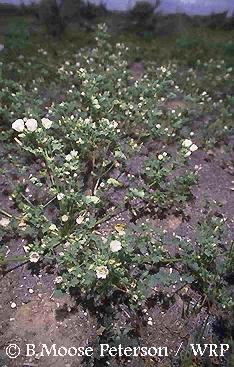Endangered Species Recovery Program | |
|
Home | News | Publications | Species profiles | Data and maps | About | Staff | Links | Department of Biological Sciences | CSU Stanislaus |

Kern mallow
Eremalche kernensis
Status
U.S.A. Endangered
Life History
As with many arid-land annuals, the form, density, phenology (timing of different stages in the life cycle), and reproduction of Kern mallow vary greatly depending on precipitation. The form can vary from single-stemmed to multiple-stemmed, with the central stem erect and the lateral stems trailing along the ground. The flowers have five petals, and the wheel-shaped fruits are divided into single-seeded segments.
Kern mallow seeds typically germinate in January and February. Flowering begins in March with fruit production beginning days thereafter; flower and fruit production may continue into May if sufficient moisture is available. The seeds fall from the fruits as soon as they are mature. Seeds are capable of germinating in the following growing season, but at least some remain ungerminated. The duration of seed viability in the soil is not known. Seed dispersal agents are unknown but probably include animals and wind. Studies showed that insects facilitated pollination of Kern mallow, but a few seeds were produced when pollinators were excluded, possibly through apomixis (i.e., seed set without fertilization). Population size of Kern mallow varies with rainfall.
Kern mallow typically occurs in the Valley Saltbush Scrub natural community, where it grows under and around saltbushes (Atriplex spp.) and in patches with other herbaceous cover, rather than in the intervening alkali scalds. Associated herbs include red brome (Bromus madritensis ssp. rubens), red-stemmed filaree (Erodium cicutarium), woolly goldfields (Lasthenia minor), and white Sierran layia (Layia pentachaeta ssp. albida). Kern mallow usually grows in areas where shrub cover is less than 25% and herbaceous cover is variable. The elevation ranges from 95 to 275 m and the soil type is alkaline, sandy loam or clay. Kern mallow occasionally has reinvaded disturbed sites when existing populations remained in adjacent areas to provide sources of seed.
Distribution
The historical distribution of Kern mallow is restricted to occurrences in western Kern County north of McKittrick, specifically specimens from the Temblor Valley, Belridge Oil Field, and two sites west of Buttonwillow.
A 1986 status survey reported three additional occurrences in Lokern, which is the local name for the area between Buttonwillow and McKittrick, Kern County. Within the last few years, more intensive surveys revealed that Kern mallow occurs intermittently within an area of approximately 100 km2 (40 mi2) in Lokern, which is best described as a single metapopulation. Other occurrences of plants presumed to be Kern mallow have been reported from sites outside of the accepted range, but they are considered to represent Parry's mallow (Eremalche parryi).
The loss and degradation of habitat in the Lokern area have been responsible for the decline of Kern mallow. Construction of the California aqueduct impacted Kern mallow by destroying plants in its path and providing water that allowed cultivation of crops in the area of endemism. Loss of habitat is also attributed to petroleum development and disposal facilities. Additional causes of habitat degradation included installation of pipelines and transmission lines and ORV use.
Approximately 85% of the Kern mallow habitat in Lokern is privately owned and thus is vulnerable to development for many uses. Other potential threats to this species' survival include competition from exotic plant species, overgrazing by sheep, and reduction of pollinator populations by malathion application.
Classification
Order MALVALES, Family MALVACEAE, Genus Eremalche, Species kernensis
Subspecies
None.
Recent Synonyms
Eremalche parryi ssp. kernensis
Other Common Names
None.
References
Bates, D.M. 1992. Gynodioecy, endangerment, and status of Eremalche kernensis (Malvaceae). Phytologia 72:48-54; Bates, D.M. 1993. Eremalche. P. 748, in The Jepson Manual: higher plants of California (J.C. Hickman, ed.). Univ. California Press, Berkeley, 1400 pp.; California Natural Diversity Database. 1995. California Dept. Fish and Game, Sacramento; Skinner, M.W., and B.M. Pavlik, eds. 1994. Inventory of rare and endangered vascular plants of California. Fifth edition. Spec. Publ. No. 1, California Native Plant Society, Sacramento, 338 pp.
Size
Stem length:
2.5-50 cm (1-20 inches)
Identification
Controversy surrounding the taxonomy of this species centers around the gender, color, and size of flowers indicative of Kern mallow versus Parry's mallow. Some populations in the Kern/Parry's mallow complex are gynodioecious, meaning that a population contains a mixture of plants that have only pistillate (female) flowers and plants that have only bisexual flowers (with both male and female parts). Some experts believe that gynodioecious populations represent Kern mallow and those populations with only bisexual flowers are Parry's mallow, whereas others maintain that both Kern mallow and Parry's mallow are gynodioecious.
The strictest definition of Kern mallow applies to populations in which white-flowered individuals predominate. Definite Parry's mallow populations consist of only pinkish-purple flowers, whereas those of questionable taxonomic affinity contain either exclusively pinkish-purple flowers or a very small proportion of white-flowered plants. Parry's mallow has larger flower parts than Kern mallow. Another closely-related species that infrequently occurs with the other two taxa is desert mallow (Eremalche exilis), which has trailing stems and bisexual flowers that are smaller than those of Kern mallow.
Authors of Profile
T.M. Sandoval and E.A. Cypher